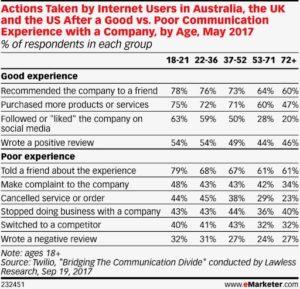Do Not Delete: Managing Negative Social Media Comments
Published on December 4, 2018, at 6:08 p.m.
by Alyssa Leach.
Picture this: You are in charge of managing social media for a brand-new restaurant recently built in an exciting location. Crowds gather for the grand opening, and because of the nature of construction, bugs show up for opening day, too.
To your dismay, the very first tweet about your restaurant mentions nothing about the great location, trendy atmosphere or five-star food. A disgusted customer has tweeted a picture of a giant cockroach in plain sight. What do you do? This blog post will help you understand why deleting content could actually be worse than letting people see it.

According to eMarketer, customers hold businesses to a higher standard of transparency than the businesses themselves. When you don’t give customers exactly that, you can expect them to take their business elsewhere. In fact, studies from eMarketer show that 75 percent of U.S. internet users will recommend a company to a friend after a positive communication interaction, while 38 percent will completely stop doing business with a company after a negative one. Therefore, it is imperative to properly manage unfavorable social media comments.
1. Receive the message
In her article“The Importance of Being Heard,” marketing professional Stacy Beer stated that “when people feel ignored, it is as though our experiences, emotions and intellect are not being valued.” As a professional organization, building relationships with current and potential customers is the key to success.
Productive conversations are a crucial part of building healthy relationships, and listening is vital to producing that type of conversation. Let customers know you hear them and validate them for feeling the way they do. In the case of the restaurant opening, you would want to acknowledge that seeing a creepy crawler next to your food is concerning.
2. Do not delete
You wouldn’t want people to think you have something to hide, would you? No matter how strong the temptation, do not delete an unfavorable comment. Believe it or not, negative feedback can actually help your company appear more credible.
However, there are certain exceptions to this rule. Some comments that feature obscenities or discriminatory words should be deleted in order to let your customers know you do not condone that kind of language.
For the most part, responding with transparent candor can pleasantly surprise your customers. Deleting a critical comment shows people that not only are you afraid of ruining your reputation, but you also couldn’t care less about their concerns.
3. Do not delay your response
It’s bad enough that someone’s negative views about your business are on a platform seen by numerous people, but do not let too much time pass before you give a well-thought-out response. According to one social business website, monitoring your social media is a 365-day-a-year, 24/7 job. Be aware and be timely. People will appreciate the concern you have for your customers.
4. Take a deep breath
We get it — you naturally want to defend your brand, but you should make sure to remain respectful. Always stay calm and remember that the way you respond can sway people away from or toward your brand. Acknowledge their frustration and give a sincere apology. Avoid using defensive language.
Sometimes, it is appropriate to use humorous or even witty responses. Take the example of M-A-C Cosmetics. After posting a picture of African-American models wearing a new lip color at New York Fashion Week, the company received negative comments with derogatory racial slurs. It addressed the issue by changing its Instagram bio to “The Official M-A-C Cosmetics Instagram. All Ages, All Races, All Sexes.” The M-A-C social media team and actively deleted new racial comments.

5. Draft, draft, draft
Responding to comments should be no different than writing a post for your business. Never trust your eyes alone; always get someone to OK what you have written. A simple typo or an insensitive reply can derail your message completely. It’s best not to cause even more reason for customers to be disappointed in your company.
6. But what do I say?
Strive to provide an apology or even a solution. This is your opportunity to turn an angry customer into a loyal one. Reply with something like “Looking forward to helping you. Can you direct message us more information?” or “Thanks so much for letting us know. Has the issue been resolved for you?” It is smart to publicize other options for customers to talk to you. This can help to diffuse the situation.
7. Be on the lookout
Congratulations! You have just successfully managed your first negative social media comment for the new restaurant. Don’t forget, if you have a social media presence, you must expect negativity. Remember that feedback, if reviewed appropriately, can be a great help to you and your business. Continue to monitor your social spaces so that your customers feel confident in your company — with or without cockroaches.
Alyssa Leach is a senior studying public relations at Brigham Young University.




